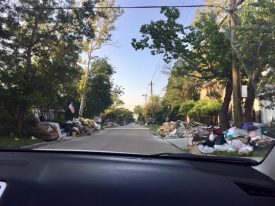What happens after the hurricane?
By Rachel Freemen
Rachel Freeman, a recent SMEA graduate, has spent the past weeks in Houston helping her family and friends recover from Hurricane Harvey. Below Rachel shares her experiences and observations in the aftermath of the storm.
Now that the water has greatly receded, life in Houston appears normal at first glance, save for the large piles of debris that line the curbs of streets throughout the city. The cleanup and repairs required to recover from Harvey are vast and have already begun to create new challenges of their own.
Though Harvey was a behemoth of a storm, Houstonians are no strangers to floods. People here know that the city’s naturally hot and humid climate combined with a soaking wet house creates the perfect petri dish for mold to grow like wildfire. As soon as flood waters recede, it’s imperative to immediately get into your place and begin salvaging and drying anything you can, as quickly as you can. This doesn’t just mean saving material items and furniture, but also entails ripping out carpet, floors, and sheetrock- any part of the actual house that’s wet.
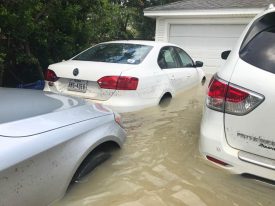 A new problem now is that work has largely resumed for most people, making it difficult to continue the process of cleaning and rebuilding their homes and lives. Not only does this slow down much-needed damage control at peoples’ residences, but it introduces new obstacles of figuring out how to even get to work. Homes flooded, yes, but so did cars, and in Houston you absolutely need a car to get anywhere. Rental cars are hard to come by, and some people I’ve spoken to have had to go all the way to Dallas or Austin in borrowed vehicles from friends to get a rental car of their own.
A new problem now is that work has largely resumed for most people, making it difficult to continue the process of cleaning and rebuilding their homes and lives. Not only does this slow down much-needed damage control at peoples’ residences, but it introduces new obstacles of figuring out how to even get to work. Homes flooded, yes, but so did cars, and in Houston you absolutely need a car to get anywhere. Rental cars are hard to come by, and some people I’ve spoken to have had to go all the way to Dallas or Austin in borrowed vehicles from friends to get a rental car of their own.
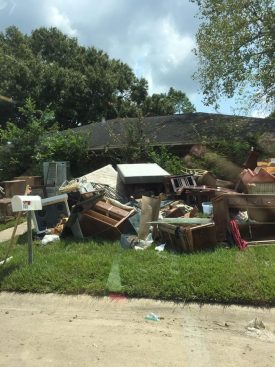 Many people I know have opted to skip volunteering at shelters and instead help anyone they can deal with the wreckage of their homes. While passing out meals and directing traffic at any of the city’s shelter’s is noble and needed work, the immediate need is still within the communities themselves. For many, this literally means driving around a neighborhood after work or on the weekend, and stopping to help anyone they see. And truly, there is no shortage of families and neighbors to help out. I’m attaching some photos here that I took just driving around my neighborhood. This is what it looks like everywhere.
Many people I know have opted to skip volunteering at shelters and instead help anyone they can deal with the wreckage of their homes. While passing out meals and directing traffic at any of the city’s shelter’s is noble and needed work, the immediate need is still within the communities themselves. For many, this literally means driving around a neighborhood after work or on the weekend, and stopping to help anyone they see. And truly, there is no shortage of families and neighbors to help out. I’m attaching some photos here that I took just driving around my neighborhood. This is what it looks like everywhere.
The 50% Rule
Last week the Mayor of Bellaire, Andrew Friedberg, sent an email to all Bellaire residents about what’s being referred to as the “50% Rule.” Essentially, the “50% Rule” states that if the cost of improvement or repairs to a damaged house from the flood exceeds 50% of the market value of the structure, then the structure has to be brought into compliance. So what does this actually mean? Let’s break it down.
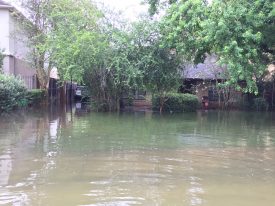
Let’s say you live in an older house that isn’t worth much more than its property value. This is the case for a lot of smaller, older homes in the City of Bellaire, a very wealthy and coveted place to live where small homes are typically torn down at purchase to be replaced by giant mansions. But there are still quite a few small structures standing, inhabited by families and residents who have been there for a long time, or who can’t afford to live in a large house and remain in Bellaire.
So let’s say you are one of those people living a smaller, older home, the total market value of which, for arguments sake here, is just $3,000. And let’s say your home flooded in Harvey. It would not be hard to exceed 50% of the value of your structure in necessary repairs and improvements. And now that those required repairs exceed $1500, you have to bring your entire home into compliance. And since your home is an older home, built before new permitting and urban planning laws, chances are that “bringing your home into compliance” would require changes to the foundation itself, which would mean tearing your house down altogether. Perhaps you don’t have to tear the entire structure down, but one can imagine how much more expensive it will now be for you to recover from this storm.
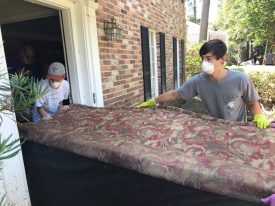
Who does this affect the most? Well definitely not the wealthy. Because let’s say you live in a giant mansion in Bellaire and your home happened to flood too. Okay, well the market value of your giant mansion is probably worth a lot more than just $3,000. So it’s less likely that costs of repairs and improvements will exceed 50% of the value of your home. Even if it did, however, chances are you will probably have more of an ability to pay for those repairs.
My grandfather’s house, for example, is one of those older homes. It was built in the 1930s and, before Harvey, had never flooded in its long history. But now it sits smack dab in the middle of two very large homes, neither of which flooded. But since those large structures were built on higher foundations, the water flowed downward straight into my grandfather’s house. Of the multiple quotes we received from professional companies on how much it would cost to simply get the molding, wood floors ripped out, the cheapest to do just two of the rooms in the house was $5600. And that’s just to rip out the layers of wood flooring. That doesn’t include taking out sheetrock or carpet (we’d already done that). And it definitely didn’t include any actual repairs.
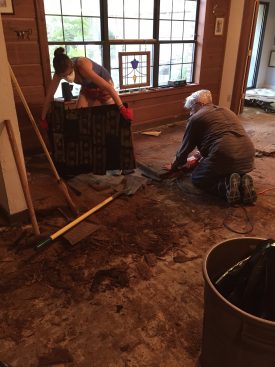
Furthermore, this “50% Rule” is cumulative of past repair costs from previous floods (of which we’ve had many in Houston). This means that for homes that flooded before, new flooding from Harvey might bring the total cost of repair from all of those years above that 50% mark. The “50% Rule” is apparently mandated by FEMA, meaning it doesn’t just apply to the residents of Bellaire (a sort of city within a city), but to all residents of the City of Houston- some 2.3 million people.
So where does this leave people? The Mayor’s email regarding the 50% Rule posted on his public blog and titled “After All This, Will I Even Be Allowed to Rebuild?” Many residents are doing as much of the work right now on their own as they possibly can. Not only are many professionals booked up now on jobs around the city, but implications of the “50% Rule” mean trying to figure out ways to keep costs down as much as possible. Instead of paying $5600 to have someone else rip out the floors in my grandfather’s house, my family and I, like many people, started doing it ourselves.
The problem with this? Well, for one thing, we aren’t professionals, nor do we have equipment that professionals may use. This means that it takes a whole lot longer to do anything.
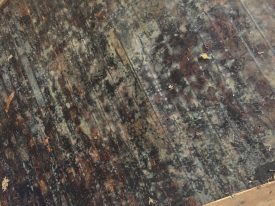
The second problem is that since it takes longer, mold has more time to grow. If only I could describe the smell you. Many stores like Home Depot and Lowes are out of the proper safety equipment and tools, so the cloth masks many of us have been using are not foolproof. They help, but you can still breathe mold in through them, meaning a much higher danger of more people getting sick. You start coughing more, can literally feel it in your lungs, but have to keep working, because in the end it has to get done. And if you’re not rich, no one else is going to do it for you. So how do you rebuild when there are actual rules in place that hurt those that aren’t at the top of the income bracket? It makes me wonder what the City of Houston (currently the most diverse city in the country) will look like in the future.
Here is the link to the Mayor’s notice about the 50% Rule.
